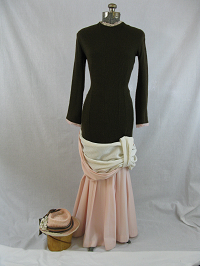
- Details
- Category: 19th century
- Hits: 2894
1878
With the invention of the electric light, the sewing machine, and mass production, there was a general rise in the status of the middle class. The positions of women became more important. In the early 1870s, the National Women’s Suffrage Association was born. Women looked to careers other than marriage, and that brought about changes in costume. Sports became more important in American life. In addition to croquet and archery, tennis became one of the favorite games for both men and women.
In the late 1870s the bustle has deflated as seen in this tennis dress, but the new silhouette did little to give more freedom of movement to the player. This is a 1878 jersey tennis costume. The bustle has deflated, but the new silhouette was far from giving more freedom of movement to the wearer. The bodice of this knitted wool tunic dress fits the figure very closely by means of seams and darts down to well below the hips. It presents the entire torso from shoulder to knee defined as clearly as if in a body stocking. The neckline is high, while the sleeve is long and both are trimmed in lace. The dress is swathed round the knee and wrapped in folds resembling the swaddling bands of the medieval infant causing ladies to walk with very small steps. There was no sign of the feet and women appeared to move as if propelled by some invisible machinery. The white drapery is pleated into the center back and falls around the front. The longer pink scarf drapery follows the first with the extra fullness looped up at the center back. The tunic is closed with a long row of hooks and eyes. The corset was seamed and corded to attain the proper figure and gussets added fullness to the bust. The chemise is now very short. Underclothes also worn were pantaloons or bloomers, which were named after Mrs. Amelia Bloomer, and stockings of black fishnet supported by knee garters.
This reproduction was made by Helen Terza based on an image in Blum 1974: 128 (d).
Click image for detailed views.
- Details
- Category: 19th century
- Hits: 2748
1860s
Amelia Bloomer introduced dress reform for women in the 1850s, but trousers, even long, full ones, were considered masculine. The only place deemed proper for a woman to appear in them was at the beach. Can you imagine what the beach looked like in the 1860s?
This two piece bathing suit consists of a tunic and drawers. Many women went to the beaches, but few of them actually swam. Suits were made of non-clinging fabric such as wool flannel, serge, or mohair. This all wool paletot dress of brick red rep (wool) is trimmed in black braid. The pants are completely lined. The buttoned waist has safety ties, in case the bather pops a button.
These heavy wool swimsuits with all the accessories - long stockings, laced up bathing slippers, fancy caps - made it unsafe in the deeper water. Annette Kellerman, an Australian swimming star, became famous in synchronized swimming in 1907. She helped change women's swimming fashions. Esther Williams. Today's beach wear is varied and comfort has finally been an established practice. So whether you wear a big shirt or sarong to make your way to the water, remember the swim suit has a long and noble history.
This reproduction was made by Peggy Fields.
Click the image for detailed views.
Page 13 of 13


